Paleoproterozoic Multiple Tectonothermal Events in the Longshoushan Area, Western North China Craton and Their Geological Implication: Evidence from Geochemistry, Zircon U–Pb Geochronology and Hf Isotopes
Abstract
1. Introduction
2. Geological Setting
3. Field Relationship and Sample Descriptions
3.1. Metagabbro
3.2. Metadiorite
3.3. Quartz Syenite
3.4. Granitic Leucosome
3.5. Pegmatoid Leucosome
4. Analytical Methods
4.1. Whole-Rock Major and Trace Elements
4.2. Zircon U–Pb Dating
4.3. Zircon Lu–Hf Isotopes
5. Analytical Results
5.1. Geochemical Characteristics
5.1.1. Meta-Mafic Rocks
5.1.2. Quartz Syenite
5.1.3. Leucosome
5.2. Zircon U–Pb and Hf Isotopes
5.2.1. Metagabbro (JZ-12)
5.2.2. Metadiorite (JC-119)
5.2.3. Quartz Syenite (JZ-31)
5.2.4. Granitic Leucosome (JZ-38)
5.2.5. Pegmatoid Leucosome (JZ-70)
6. Discussion
6.1. Formation Age
6.2. Crustal Growth of the LS Area from Neoarchean to Paleoproterozoic
6.3. Petrogenetic Implications
6.3.1. Meta-Mafic Rocks
6.3.2. Quartz Syenite
6.3.3. Leucosome
6.4. Model for Tectonic Evolution of LS Area
6.5. Implications for Comparison to the Other Parts of the NCC
7. Conclusions
- In the LS area, there were three major periods of magmatism during Paleoproterozoic: ~2.5–2.45 Ga, ~2.1–2.0 Ga and ~1.95–1.91 Ga, and three major regional metamorphism/anataxis events at ~1.93–1.89 Ga, ~1.86–1.84 Ga and ~1.81 Ga, respectively.
- The age-Hf isotope data indicate that two main crustal growth events happened at ~2.9–2.5 Ga and ~2.2–2.0 Ga in the LS area. And the two episodes are confirmed by the depositional ages of the Baijiazuizi Formation and Tamazigou Formation of the LS Group, respectively.
- In the middle Paleoproterozoic, the LS area entered an intraplate extensional setting. After that, the LS area was in a strongly convergent collision environment. In the late Paleoproterozoic, the research area is experienced continental collision at 1.94~1.93 Ga, and anatectic/metamorphic events by causing continental subduction at 1.93–1.89 Ga and exhumation at ~1.86–1.84 Ga and ~1.81 Ga.
- The geochronological framework and tectonic evolution of the LS area show stronger affinity toward the Khondalite Belt rather than the Yinshan Block, supporting the argument that the Alxa Block is a western extension of the Khondalite Belt.
Supplementary Materials
Author Contributions
Acknowledgments
Conflicts of Interest
References
- Zhao, G.C.; Sun, M.; Wilde, S.A.; Li, S.Z. Late Archean to Paleoproterozoic evolution of the North China Craton: Key issues revisited. Precambrian Res. 2005, 136, 177–202. [Google Scholar] [CrossRef]
- Zhai, M.G.; Santosh, M. The early Precambrian odyssey of the North China Craton: A synoptic overview. Gondwana Res. 2011, 20, 6–25. [Google Scholar] [CrossRef]
- Zhao, G.C.; Wilde, S.A.; Cawood, P.A.; Lu, L.Z. Tectonothermal history of the basement rocks in the western zone of the North China Craton and its tectonic implications. Tectonophysics 1999, 310, 37–53. [Google Scholar] [CrossRef]
- Zhao, G.C.; Sun, M.; Wilde, S.A.; Li, S.Z. Assembly, accretion and breakup of the Paleo-Mesoproterozoic Columbia Supercontinent: Records in the North China Craton. Gondwana Res. 2003, 6, 417–434. [Google Scholar] [CrossRef]
- Kusky, T.M.; Li, J.H. Paleoproterozoic tectonic evolution of the North China Craton. J. Asian Earth Sci. 2003, 22, 383–397. [Google Scholar] [CrossRef]
- Kusky, T.M.; Li, J.H.; Santosh, M. The Paleoproterozoic North Hebei Orogen: North China craton's collisional suture with the Columbia supercontinent. Gondwana Res. 2007, 12, 4–28. [Google Scholar] [CrossRef]
- Liu, S.W.; Pan, Y.M.; Xie, Q.L.; Zhang, J.; Li, Q.G.; Yang, B. Geochemistry of the paleoproterozonic Nanying granitic gneisses in the Fuping complex: Implications for the tectonic evolution of the Central Zone, North China Craton. J. Asian Earth Sci. 2005, 24, 643–658. [Google Scholar] [CrossRef]
- Zhang, J. Th-U–Pb monazite geochronology of the Lüliang and Wutai Complexes: Constraints on the tectonothermal evolution of the Trans-North China Orogen. Precambrian Res. 2006, 148, 205–224. [Google Scholar]
- Xia, X.P.; Sun, M.; Zhao, G.C.; Luo, Y. LA-ICP-MS U–Pb geochronology of detrital zircons from the Jining Complex, North China Craton and its tectonic significance. Precambrian Res. 2006, 144, 199–212. [Google Scholar] [CrossRef]
- Xia, X.P.; Sun, M.; Zhao, G.C.; Wu, F.Y.; Xu, P.; Zhang, J.H.; Luo, Y. U–Pb and Hf isotopic study of detrital zircons from the Wulashan khondalites: Constraints on the evolution of the Ordos Terrane, Western Block of the North China Craton. Earth Planet. Sci. Lett. 2006, 241, 581–593. [Google Scholar] [CrossRef]
- Santosh, M.; Tsunogae, T.; Li, J.H.; Liu, S.J. Discovery of sapphirine-bearing Mg-Al granulites in the North China Craton: Implications for Paleoproterozoic ultrahigh temperature metamorphism. Gondwana Res. 2007, 11, 263–285. [Google Scholar] [CrossRef]
- Santosh, M.; Tsunogae, T.; Ohyama, H.; Sato, K.; Li, J.H.; Liu, S.J. Carbonic metamorphism at ultrahigh-temperatures: Evidence from North China Craton. Earth Planet. Sci. Lett. 2008, 266, 149–165. [Google Scholar] [CrossRef]
- Santosh, M.; Wilde, S.A.; Li, J.H. Timing of Paleoproterozoic ultrahigh- temperature metamorphism in the North China Craton: Evidence from SHRIMP U–Pb zircon geochronology. Precambrian Res. 2007, 159, 178–196. [Google Scholar] [CrossRef]
- Zhai, M. Multi-stage crustal growth and cratonization of the North China Craton. Geosci. Front. 2014, 5, 457–469. [Google Scholar] [CrossRef]
- Yang, Q.Y.; Santosh, M.; Collins, A.S.; Teng, X.M. Microblock amalgamation in the North China Craton: Evidence from Neoarchaean magmatic suite in the western margin of the Jiaoliao Block. Gondwana Res. 2015, 31, 96–123. [Google Scholar] [CrossRef]
- Li, S.S.; Santosh, M.; Cen, K.; Teng, X.M.; He, X.F. Neoarchean convergent margin tectonics associated with microblock amalgamation in the North China Craton: Evidence from the Yishui Complex. Gondwana Res. 2016, 38, 113–131. [Google Scholar] [CrossRef]
- Santosh, M.; Teng, X.M.; He, X.F.; Tang, L.; Yang, Q.Y. Discovery of Neoarchean suprasubduction zone ophiolite suite from Yishui Complex in the North China Craton. Gondwana Res. 2016, 38, 1–27. [Google Scholar] [CrossRef]
- Geng, Y.S.; Wang, X.S.; Shen, Q.H.; Chun-Ming, W.U. Redefinition of the Alxa Group-complex (Precambrian metamorphic basement) in the Alxa area, Inner Mongolia. Geol. China 2006, 33, 138–145. (In Chinese) [Google Scholar]
- Gong, J.H.; Zhang, J.X.; Wang, Z.Q.; Yu, S.Y.; Li, H.K.; Li, Y.S. Origin of the Alxa Block, western China: New evidence from zircon U–Pb geochronology and Hf isotopes of the Longshoushan Complex. Gondwana Res. 2016, 36, 359–375. [Google Scholar] [CrossRef]
- Gong, J.H.; Zhang, J.X.; Yu, S.Y. The origin of Longshoushan Group and associated rocks in the Southern part of the Alxa Block: Constraint from LA-ICP-MS U–Pb zircon dating. Acta Pet. Miner. 2011, 30, 795–818. (In Chinese) [Google Scholar]
- Zhang, J.X.; Gong, J.H.; Yu, S.Y.; Li, H.K.; Hou, K.J. Neoarchean-Paleoproterozoic multiple tectonothermal events in the western Alxa block, North China Craton and their geological implication: Evidence from zircon U–Pb ages and Hf isotopic composition. Precambrian Res. 2013, 235, 36–57. [Google Scholar] [CrossRef]
- Dan, W.; Li, X.H.; Guo, J.H.; Liu, Y.; Wang, X.C. Paleoproterozoic evolution of the eastern Alxa Block, westernmost North China: Evidence from in situ zircon U–Pb dating and Hf-O isotopes. Gondwana Res. 2012, 21, 838–864. [Google Scholar] [CrossRef]
- Zhang, J.X.; Gong, J.H. Revisiting the nature and affinity of the Alxa Block. Acta Pet. Sin. 2018, 34, 940–962. (In Chinese) [Google Scholar]
- Santosh, M. Assembling North China Craton within the Columbia supercontinent: The role of double-sided subduction. Precambrian Res. 2010, 178, 149–167. [Google Scholar] [CrossRef]
- Wan, Y.S.; Liu, D.Y.; Dong, C.Y.; Xu, Z.Y.; Wang, Z.J.; Wilde, S.A.; Yang, Y.H.; Liu, Z.H.; Zhou, H.Y. The Precambrian Khondalite Belt in the Daqingshan area, North China Craton: Evidence for multiple metamorphic events in the Palaeoproterozoic era. Geol. Soc. Lond. Spec. Publ. 2009, 323, 73–97. [Google Scholar] [CrossRef]
- Xiu, Q.Y.; Lu, S.N.; Yu, H.F.; Yang, C.L. The isotopic age evidence for main Longshoushan Group contributing to Palaeoproterozoic. Prog. Precambrian Res. 2002, 25, 93–96. (In Chinese) [Google Scholar]
- Xiu, Q.Y.; Yu, H.F.; Li, Q.; Zuo, G.C.; Li, J.W.; Cao, C.J. Discussion on the petrogenic time of Longshoushan Group, Gansu Province. Acta Geol. Sin.-Chin. Ed. 2004, 78, 366–373. (In Chinese) [Google Scholar]
- Dong, C.Y.; Liu, D.Y.; Li, J.J.; Wang, Y.S.; Zhou, H.Y.; Li, C.D.; Yang, Y.H.; Xie, L.W. Palaeoproterozoic Khondalite Belt in the western North China Craton: New evidence from SHRIMP dating and Hf isotope composition of zircons from metamorphic rocks in the Bayan Ul-Helan Mountains area. Chin. Sci. Bull. 2007, 52, 2984–2994. [Google Scholar] [CrossRef]
- Xu, A.D.; Jiang, X.D. Characteristics and geological significance of the Dunzigou Group of the mesoproterozoic in the western edge of the North China Platform. J. Earth Sci. Environ. 2003, 25, 27–31. (In Chinese) [Google Scholar]
- Xiao, P.X.; You, W.F.; Cao, X.D. Redefining of the Hanmushan Group in Longshoushan, central-western Gansu Province. Geol. Bull. China 2011, 30, 1228–1232. (In Chinese) [Google Scholar]
- Xie, C.R.; Xiao, P.X.; Yang, Z.Z.; Cao, X.D.; Hu, Y.X. Progress in the studying of the Hanmushan Group in the Longshou mountains of Gansu province. J. Stratigr. 2013, 37, 54–57. (In Chinese) [Google Scholar]
- Tung, K.A.; Yang, H.Y.; Liu, D.Y.; Zhang, J.X.; Tseng, C.Y.; Wan, Y.S. SHRIMP U–Pb geochronology of the detrital zircons from the Longshoushan Group and its tectonic significance. Chin. Sci. Bull. 2007, 52, 1414–1425. [Google Scholar] [CrossRef]
- Duan, J.; Li, C.S.; Qian, Z.Z.; Jiao, J.G. Geochronological and geochemical constraints on the petrogenesis and tectonic significance of Paleozoic dolerite dykes in the southern margin of Alxa Block, North China Craton. J. Asian Earth Sci. 2015, 111, 244–253. [Google Scholar] [CrossRef]
- Yan, H.Q.; Liu, Q.F.; Tang, Z.L.; Fan, M.C.; Wang, Q.; Ren, J.M.; Fan, C.F. Structural properties of the Longshoushan Block: Constraint from LA-ICP-MS zircon U–Pb dating. Eng. Sci. 2015, 17, 59–72. (In Chinese) [Google Scholar] [CrossRef]
- Zeng, R.Y.; Lai, J.Q.; Mao, X.C.; Li, B.; Ju, P.J.; Tao, S.L. Geochemistry, zircon U–Pb dating and Hf isotopies composition of Paleozoic granitoids in Jinchuan, NW China: Constraints on their petrogenesis, source characteristics and tectonic implication. J. Asian Earth Sci. 2016, 121, 20–33. [Google Scholar] [CrossRef]
- Song, X.Y.; Danyushevsky, L.V.; Keays, R.R.; Chen, L.M.; Wang, Y.S.; Tian, Y.L.; Xiao, J. Structural, lithological, and geochemical constraints on the dynamic magma plumbing system of the Jinchuan Ni-Cu sulfide deposit, NW China. Min. Depos. 2012, 47, 277–297. [Google Scholar] [CrossRef]
- Li, X.H.; Su, L.; Chung, S.L.; Li, Z.X.; Liu, Y.; Song, B.; Liu, D.Y. Formation of the Jinchuan ultramafic intrusion and the world’s third largest Ni-Cu sulfide deposit: Associated with the ~825 Ma south China mantle plume? Geochem. Geophys. Geosyst. 2005, 6, 1–16. [Google Scholar] [CrossRef]
- Zhang, M.J.; Kamo, S.L.; Li, C.S.; Hu, P.Q.; Ripley, E.M. Precise U–Pb zircon-baddeleyite age of the Jinchuan sulfide ore-bearing ultramafic intrusion, western China. Miner. Depos. 2010, 45, 3–9. [Google Scholar] [CrossRef]
- Jiao, J.G.; Liu, H.; Duan, J.; Hao, L.U.; Luo, D.Z.; Dong, Q.I. Hf Isotope Geochemical Characteristics and Magma Sources in Jinchuan Cu-Ni Sulfide Deposit. J. Earth Sci. Environ. 2014, 36, 58–67. (In Chinese) [Google Scholar]
- Sun, H.; Xiao, Y.L.; Gao, Y.J.; Lai, J.Q.; Hou, Z.H.; Wang, Y.Y. Fluid and melt inclusions in the Mesozoic Fangcheng basalt from North China Craton: Implications for magma evolution and fluid/melt-peridotite reaction. Contrib. Miner. Pet. 2013, 165, 885–901. [Google Scholar] [CrossRef]
- Andersen, T. Correction of common lead in U–Pb analyses that do not report 204 Pb. Chem. Geol. 2002, 192, 59–79. [Google Scholar] [CrossRef]
- Ludwig, K.R. User’s Manual for Isoplot 3.00, A Geochronological Toolkit for Microsoft Excel; Berkeley Geochronological Center, Special Publication: Berkeley, CA, USA, 2003; Volume 4, pp. 1–70. [Google Scholar]
- Woodhead, J.D.; Hergt, J.M. A preliminary appraisal of seven natural zircon reference materials for in situ Hf isotope determination. Geostand. Geoanal. Res. 2005, 29, 183–195. [Google Scholar] [CrossRef]
- Yuan, H.L.; Gao, S.; Dai, M.N.; Zong, C.L.; Günther, D.; Fontaine, G.H.; Liu, X.M.; Diwu, C.R. Simultaneous determinations of U–Pb age, Hf isotopes and trace element compositions of zircon by excimer laser-ablation quadrupole and multiple-collector ICP-MS. Chem. Geol. 2008, 247, 100–118. [Google Scholar] [CrossRef]
- Wu, F.Y.; Yang, Y.H.; Xie, L.W.; Yang, J.H.; Xu, P. Hf isotopic compositions of the standard zircons and baddeleyites used in U–Pb geochronology. Chem. Geol. 2006, 234, 105–126. [Google Scholar] [CrossRef]
- Li, X.H.; Long, W.G.; Li, Q.L.; Liu, Y.; Zheng, Y.F.; Yang, Y.H.; Chamberlain, K.R.; Wan, D.F.; Guo, C.H.; Wang, X.C. Penglai Zircon Megacrysts: A Potential New Working Reference Material for Microbeam Determination of Hf-O Isotopes and U–Pb Age. Geostand. Geoanal. Res. 2010, 34, 117–134. [Google Scholar] [CrossRef]
- Winchester, J.A.; Floyd, P.A. Geochemical discrimination of different magma series and their differentiation products using immobile elements. Chem. Geol. 1977, 20, 325–343. [Google Scholar] [CrossRef]
- Miyashiro, A. Volcanic rock series in island arcs and active continental margins. Am. J. Sci. 1974, 274, 321–355. [Google Scholar] [CrossRef]
- Frost, B.R.; Barnes, C.G.; Collins, W.J.; Arculus, R.J.; Ellis, D.J.; Frost, C.D. A geochemical classification for granitic rocks. J. Pet. 2001, 42, 2033–2048. [Google Scholar] [CrossRef]
- Maniar, P.D.; Piccoli, P.M. Tectonic discrimination of granitoids. Geol. Soci. Am. Bull. 1989, 101, 635–643. [Google Scholar] [CrossRef]
- Sun, S.S.; McDonough, W.F. Chemical and isotopic systematics of oceanic basalts: Implications for mantle composition and processes. Geol. Soc. Lond. Spec. Publ. 1989, 42, 313–345. [Google Scholar] [CrossRef]
- Yang, C.S. Pegmatoidal Alaskite in Hongshiquan Area, Gansu Province. Master’s Thesis, East China University of Technology, Shanghai, China, 2017. [Google Scholar]
- Gong, J.H. Compositions, Characteristics, Chronological Framework and Origin of Early-Precambrian Metamorphic Basement in Western Alxa Block. Ph.D. Thesis, Institute of Geology and Geophysics, Chinese Academy of Sciences, Beijing, China, 2013. (In Chinese). [Google Scholar]
- Hoskin, P.W.; Schaltegger, U. The composition of zircon and igneous and metamorphic petrogenesis. Rev. Miner. Geochem. 2003, 53, 27–62. [Google Scholar] [CrossRef]
- Andersson, J.; Moller, C.; Johansson, L. Zircon geochronology of migmatite gneisses along the Mylonite Zone (S Sweden): A major Sveconorwegian terrane boundary in the Baltic Shield. Precambrian Res. 2002, 114, 121–147. [Google Scholar] [CrossRef]
- Yu, S.Y.; Zhang, J.X.; Li, S.Z.; Sun, D.Y.; Li, Y.S.; Peng, Y.B. “Barrovian-type” metamorphism and in situ anatexis during continental collision: A case study from the South Altun Mountains, Western China. Acta Pet. Sin. 2016, 32, 3703–3714. (In Chinese) [Google Scholar]
- Kemp, A.I.S.; Hawkesworth, C.J.; Collins, W.J.; Gray, C.M.; Blevin, P.L. Isotopic evidence for rapid continental growth in an extensional accretionary orogen: The Tasmanides, Eastern Australia. Earth Planet. Sci. Lett. 2009, 284, 455–466. [Google Scholar] [CrossRef]
- Kemp, A.I.S.; Hawkesworth, C.J.; Paterson, B.A.; Kinny, P.D. Episodic growth of the Gondwana supercontinent from hafnium and oxygen isotopes in zircon. Nature 2006, 439, 580–583. [Google Scholar] [CrossRef] [PubMed]
- Kemp, A.I.S.; Hickman, A.H.; Kirkland, C.L.; Vervoort, J.D. Hf isotopes in detrital and inherited zircons of the Pilbara Craton provide no evidence for Hadean continents. Precambrian Res. 2015, 261, 112–126. [Google Scholar] [CrossRef]
- Lin, T.H.; Chung, S.L.; Chiu, H.Y.; Wu, F.Y.; Yeh, M.W.; Searle, M.P.; Iizuka, Y. Zircon U–Pb and Hf isotope constraints from the Ailao Shan-Red River shear zone on the tectonic and crustal evolution of southwestern China. Chem. Geol. 2012, 291, 23–37. [Google Scholar] [CrossRef]
- Condie, K.C.; Beyer, E.; Belousova, E.; Griffin, W.L.; O’Reilly, S.Y. U–Pb isotopic ages and Hf isotopic composition of single zircons: The search for juvenile Precambrian continental crust. Precambrian Res. 2005, 139, 42–100. [Google Scholar] [CrossRef]
- Jiang, N.; Guo, J.H.; Zhai, M.G.; Zhang, S.Q. ~2.7 Ga crust growth in the North China craton. Precambrian Res. 2010, 179, 37–49. [Google Scholar] [CrossRef]
- Geng, Y.S.; Du, L.L.; Ren, L.D. Growth and reworking of the early Precambrian continental crust in the North China Craton: Constraints from zircon Hf isotopes. Gondwana Res. 2012, 21, 517–529. [Google Scholar] [CrossRef]
- Vervoort, J.D.; Blichert-Toft, J. Evolution of the depleted mantle: Hf isotope evidence from juvenile rocks through time. Geochim. Cosmochim. Acta 1999, 63, 533–556. [Google Scholar] [CrossRef]
- Blichert-Toft, J.; Albarède, F. The Lu–Hf isotope geochemistry of chondrites and the evolution of the mantle-crust system. Earth Planet. Sci. Lett. 1997, 148, 243–258. [Google Scholar] [CrossRef]
- Tang, Z.L. Metallogenic Systems and Metallotectonic Dynamics in the Southwest Margin (The Longshoushan Mountains and the Qilianshan Mountains) of North China Paleocontinent; Geological Publishing House: Beijing, China, 2002. (In Chinese) [Google Scholar]
- Li, B.; Jiang, S.Y.; Zhang, Q.; Zhao, H.X.; Zhao, K.D. Cretaceous crust-mantle interaction and tectonic evolution of Cathaysia Block in South China: Evidence from pulsed mafic rocks and related magmatism. Tectonophysics 2015, 661, 136–155. [Google Scholar] [CrossRef]
- Hergt, J.M.; Peate, D.W.; Hawkesworth, C.J. The petrogenesis of Mesozoic Gondwana low-Ti flood basalts. Earth Planet. Sci. Lett. 1991, 105, 134–148. [Google Scholar] [CrossRef]
- Meng, E.; Liu, F.L.; Liu, P.H.; Liu, C.H.; Yang, H.; Wang, F.; Shi, J.R.; Cai, J. Petrogenesis and tectonic significance of Paleoproterozoic meta-mafic rocks from central Liaodong Peninsula, northeast China: Evidence from zircon U–Pb dating and in situ Lu–Hf isotopes, and whole-rock geochemistry. Precambrian Res. 2014, 247, 92–109. [Google Scholar] [CrossRef]
- Xiao, B.; Chen, H.Y.; Hollings, P.; Han, J.S.; Wang, Y.F.; Yang, J.T.; Cai, K.D. Magmatic evolution of the Tuwu-Yandong porphyry Cu belt, NW China: Constraints from geochronology, geochemistry and Sr-Nd-Hf isotopes. Gondwana Res. 2017, 43, 74–91. [Google Scholar] [CrossRef]
- Ma, L.; Jiang, S.Y.; Hou, M.L.; Dai, B.Z.; Jiang, Y.H.; Yang, T.; Zhao, K.D.; Pu, W.; Zhu, Z.Y.; Xu, B. Geochemistry of Early Cretaceous calc-alkaline lamprophyres in the Jiaodong Peninsula: Implication for lithospheric evolution of the eastern North China Craton. Gondwana Res. 2014, 25, 859–872. [Google Scholar] [CrossRef]
- Shu, S.Y.; Yang, X.Y.; Liu, L.; Lu, W.; Cao, J.Y.; Gao, E.G. Dual Geochemical Characteristics for the Basic Intrusions in the Yangtze Block, South China: New Evidence for the Breakup of Rodinia. Minerals 2018, 8, 228. [Google Scholar] [CrossRef]
- Taylor, S.R.; Mclennan, S.M.; Armstrong, R.L.; Tarney, J. The composition and evolution of the continental crust: Rare earth element evidence from sedimentary rocks. Philos. Trans. R. Soc. Lond. 1981, 301, 381–399. [Google Scholar] [CrossRef]
- Chi, Q.H.; Yan, M.C. Handbook of Elemental Abundance for Applied Geochemistry; Geological Publishing House: Beijing, China, 2007. (In Chinese) [Google Scholar]
- Wang, K.X.; Sun, T.; Chen, P.R.; Ling, H.F.; Xiang, T.F. The geochronological and geochemical constraints on the petrogenesis of the Early Mesozoic A-type granite and diabase in northwestern Fujian province. Lithos 2013, 179, 364–381. [Google Scholar] [CrossRef]
- Cao, J.; Ye, H.S.; Chen, X.D.; He, W.; Wang, P. Geochemistry, zircon U–Pb age, and Lu–Hf isotope of the granite porphyry in Leimengou Mo deposit in the east Qinling Molybdenum ore belt, China. Minerals 2018, 8, 293. [Google Scholar] [CrossRef]
- Watson, E.B.; Harrison, T.M. Zircon saturation revisited: Temperature and composition effects in a variety of crustal magma types. Earth Planet. Sci. Lett. 1983, 64, 295–304. [Google Scholar] [CrossRef]
- Skjerlie, K.P.; Johnston, A.D. Vapor-absent melting at 10 kbar of a biotite-and amphibole-bearing tonalitic gneiss: Implications for the generation of A-type granites. Geology 1992, 20, 263–266. [Google Scholar] [CrossRef]
- Douce, A.E.P. Generation of metaluminous A-type granites by low-pressure melting of calc-alkaline granitoids. Geology 1997, 25, 743–746. [Google Scholar] [CrossRef]
- Wolf, M.B.; London, D. Apatite dissolution into peraluminous haplogranitic melts: An experimental study of solubilities and mechanisms. Geochim. Cosmochim. Acta 1994, 58, 4127–4145. [Google Scholar] [CrossRef]
- Whalen, J.B.; Currie, K.L.; Chappell, B.W. A-type granites: Geochemical characteristics, discrimination and petrogenesis. Contrib. Miner. Pet. 1987, 95, 407–419. [Google Scholar] [CrossRef]
- Eby, G.N. The A-type granitoids: A review of their occurrence and chemical characteristics and speculations on their petrogenesis. Lithos 1990, 26, 115–134. [Google Scholar] [CrossRef]
- Yang, L.Z.; Wu, X.B.; Cao, J.Y.; Hu, B.; Zhang, X.W.; Gong, Y.S.; Liu, W.D. Geochronology, Petrology, and Genesis of Two Granitic Plutons of the Xianghualing Ore Field in South Hunan Province: Constraints from Zircon U–Pb Dating, Geochemistry, and Lu–Hf Isotopic Compositions. Minerals 2018, 8, 213. [Google Scholar] [CrossRef]
- Eby, G.N. Chemical subdivision of the A-type granitoids: Petrogenetic and tectonic implications. Geology 1992, 20, 641–644. [Google Scholar] [CrossRef]
- Wu, F.Y.; Sun, D.Y.; Li, H.M.; Jahn, B.M.; Wilde, S. A-type granites in northeastern China: Age and geochemical constraints on their petrogenesis. Chem. Geol. 2002, 187, 143–173. [Google Scholar] [CrossRef]
- Du, L.L.; Yang, C.H.; Wang, W.; Ren, L.D.; Wan, Y.S.; Wu, J.S.; Zhao, L.; Song, H.X.; Geng, Y.S.; Hou, K.J. Paleoproterozoic rifting of the North China Craton: Geochemical and zircon Hf isotopic evidence from the 2137 Ma Huangjinshan A-type granite porphyry in the Wutai area. J. Asian Earth Sci. 2013, 72, 190–202. [Google Scholar] [CrossRef]
- Clemens, J.D.; Holloway, J.R.; White, A.J.R. Origin of an A-type granite: Experimental constraints. Am. Miner. 1986, 71, 317–324. [Google Scholar]
- King, P.L.; Chappell, B.W.; Allen, C.M.; White, A.J.R. Are A-type granites the high-temperature felsic granites? Evidence from fractionated granites of the Wangrah Suite. Aust. J. Earth Sci. 2001, 48, 501–514. [Google Scholar] [CrossRef]
- Zheng, Y.F.; Wu, Y.B.; Zhao, Z.F.; Zhang, S.; Xu, P.; Wu, F. Metamorphic effect on zircon Lu–Hf and U–Pb isotope systems in ultrahigh-pressure eclogite-facies metagranite and metabasite. Earth Planet. Sci. Lett. 2005, 240, 378–400. [Google Scholar] [CrossRef]
- Wu, F.Y.; Liu, X.C.; Ji, W.Q.; Wang, J.M.; Yang, L. Highly fractionated granites: Recognition and research. Sci. China Earth Sci. 2017, 7, 1–19. [Google Scholar] [CrossRef]
- Chen, G.N.; Grapes, R. Granite Genesis: In Situ Melting and Crusta Evolution; Springer: Dordrecht, The Netherlands, 2007. [Google Scholar]
- Zhai, M.G.; Peng, P. Paleoproterozoic events in the North China craton. Acta Pet. Sin. 2007, 23, 2665–2682. (In Chinese) [Google Scholar]
- Zhai, M.G. Cratonization and the Ancient North China Continent: A summary and review. Sci. China Earth Sci. 2011, 54, 1110–1120. [Google Scholar] [CrossRef]
- Liu, Y. Characteristics and Their Geological Significance of Paleoproterozoic Granite in Jinchuan, Gansu Province. Master’s Thesis, China University of Geosciences, Beijing, China, 2008. (In Chinese). [Google Scholar]
- Wang, Q. Study on Metamorphism of Longshoushan Baijiazuizi Group. Master’s Thesis, Chang’an University, Xi’an, China, 2014. (In Chinese). [Google Scholar]
- Loiselle, M.C.; Wones, D.R. Characteristics and origin of anorogenic granites. Geol. Soci. Am. Abstr. Programs 1979, 11, 468. [Google Scholar]
- Whalen, J.B.; Jenner, G.A.; Longstaffe, F.J.; Robert, F.; Gariépy, C. Geochemical and isotopic (O, Nd, Pb and Sr) constraints on A-type granite petrogenesis based on the Topsails igneous suite, Newfoundland Appalachians. J. Pet. 1996, 37, 1463–1489. [Google Scholar] [CrossRef]
- Pearce, J.A.; Norry, M.J. Petrogenetic implications of Ti, Zr, Y, and Nb variations in volcanic rocks. Contrib. Miner. Pet. 1979, 69, 33–47. [Google Scholar] [CrossRef]
- Sun, S.Q.; Zhang, C.; Zhao, S. Identification of the tectonic settings for continental intraplate by trace elements. Geotecton. Metallog. 2007, 31, 104–109. [Google Scholar]
- Condie, K.C. Geochemical changes in baslts and andesites across the Archean-Proterozoic boundary: Identification and significance. Lithos 1989, 23, 1–18. [Google Scholar] [CrossRef]
- Shervais, J.W. Ti-V plots and the petrogenesis of modern and ophiolitic lavas. Earth Planet. Sci. Lett. 1982, 59, 101–118. [Google Scholar] [CrossRef]
- Wu, Y.B.; Zheng, Y.F.; Zhang, S.B.; Zhao, Z.F.; Wu, F.Y.; Liu, X.M. Zircon U–Pb ages and Hf isotope compositions of migmatite from the North Dabie terrane in China: Constraints on partial melting. J. Metamorph. Geol. 2007, 25, 991–1009. [Google Scholar] [CrossRef]
- Villaseca, C.; Romera, C.M.; Barbero, L. Melts and residua geochemistry in a low-to-mid crustal section (Central Spain). Phys. Chem. Earth Part A Solid Earth Geodesy 2001, 26, 273–280. [Google Scholar] [CrossRef]
- Liu, F.L.; Robinson, P.T.; Gerdes, A.; Xue, H.M.; Liu, P.H.; Liou, J.G. Zircon U–Pb ages, REE concentrations and Hf isotope compositions of granitic leucosome and pegmatite from the north Sulu UHP terrane in China: Constraints on the timing and nature of partial melting. Lithos 2010, 117, 247–268. [Google Scholar] [CrossRef]
- Liu, F.L.; Robinson, P.T.; Liu, P.H. Multiple partial melting events in the Sulu UHP terrane: Zircon U–Pb dating of granitic leucosomes within amphibolite and gneiss. J. Metamorph. Geol. 2012, 30, 887–906. [Google Scholar] [CrossRef]
- Aikman, A.B.; Harrison, T.M.; Lin, D. Evidence for Early (>44 Ma) Himalayan Crustal Thickening, Tethyan Himalaya, southeastern Tibet. Earth Planet. Sci. Lett. 2008, 274, 14–23. [Google Scholar] [CrossRef]
- Zeng, L.S.; Gao, L.E.; Xie, K.J.; Liu, Z.J. Mid-Eocene high Sr/Y granites in the Northern Himalayan Gneiss Domes: Melting thickened lower continental crust. Earth Planet. Sci. Lett. 2011, 303, 251–266. [Google Scholar] [CrossRef]
- Rubatto, D.; Chakraborty, S.; Dasgupta, S. Timescales of crustal melting in the Higher Himalayan Crystallines (Sikkim, Eastern Himalaya) inferred from trace element-constrained monazite and zircon chronology. Contrib. Miner. Pet. 2013, 165, 349–372. [Google Scholar] [CrossRef]
- Hou, G.T.; Santosh, M.; Qian, X.L.; Lister, G.S.; Li, J.H. Configuration of the Late Paleoproterozoic supercontinent Columbia: Insights from radiating mafic dyke swarms. Gondwana Res. 2008, 14, 395–409. [Google Scholar] [CrossRef]
- Condie, K.C.; Aster, R.C. Episodic zircon age spectra of orogenic granitoids: The supercontinent connection and continental growth. Precambrian Res. 2010, 180, 227–236. [Google Scholar] [CrossRef]
- Zhao, G.C.; Cawood, P.A. Precambrian geology of China. Precambrian Res. 2012, 222, 13–54. [Google Scholar] [CrossRef]
- Guo, J.H.; Zhai, M.G.; Xu, R.H. Timing of the granulite facies metamorphism in the Sanggan area, North China craton: Zircon U–Pb geochronology. Sci. China 2001, 44, 1010–1018. [Google Scholar] [CrossRef]
- Geng, Y.S.; Zhou, X.W.; Wang, X.S.; Ren, L.D. Late-Paleoproterozoic granite events and their geological significance in Helanshan area, Inner Mongolia: Evidence from geochronology. Acta Pet. Sin. 2009, 25, 1830–1842. (In Chinese) [Google Scholar]
- Wan, Y.S.; Xu, Z.Y.; Dong, C.Y.; Nutman, A.; Ma, M.Z.; Xie, H.Q.; Liu, S.J.; Liu, D.Y.; Wang, H.C.; Cu, H. Episodic Paleoproterozoic (∼2.45, ∼1.95 and ∼1.85 Ga) mafic magmatism and associated high temperature metamorphism in the Daqingshan area, North China Craton: SHRIMP zircon U–Pb dating and whole-rock geochemistry. Precambrian Res. 2013, 224, 71–93. [Google Scholar] [CrossRef]
- Dan, W.; Li, X.H.; Wang, Q.; Wang, X.C.; Liu, Y.; Wyman, D.A. Paleoproterozoic S-type granites in the Helanshan Complex, Khondalite Belt, North China Craton: Implications for rapid sediment recycling during slab break-off. Precambrian Res. 2014, 254, 59–72. [Google Scholar] [CrossRef]
- Guo, J.H.; O’Brien, P.J.; Zhai, M. High-pressure granulites in the Sanggan area, North China craton: Metamorphic evolution, P–T paths and geotectonic significance. J. Metamorph. Geol. 2002, 20, 741–756. [Google Scholar]
- Peng, P.; Zhai, M.G.; Zhang, H.F.; Guo, J.H. Geochronological constraints on the Paleoproterozoic evolution of the North China Craton: SHRIMP zircon ages of different types of mafic dikes. Int. Geol. Rev. 2005, 47, 492–508. [Google Scholar] [CrossRef]
- Dong, C.Y.; Wan, Y.S.; Xu, Z.Y.; Liu, D.Y.; Yang, Z.S.; Ma, M.Z.; Xie, H.Q. SHRIMP zircon U–Pb dating of late Paleoproterozoic kondalites in the Daqing Mountains area on the North China Craton. Sci. China Earth Sci. 2013, 56, 115–125. [Google Scholar] [CrossRef]
- Yin, C.Q.; Zhao, G.C.; Guo, J.H.; Sun, M.; Xia, X.P.; Zhou, X.W.; Liu, C.H. U–Pb and Hf isotopic study of zircons of the Helanshan Complex: Constrains on the evolution of the Khondalite Belt in the Western Block of the North China Craton. Lithos 2011, 122, 25–38. [Google Scholar] [CrossRef]
- Yin, C.Q.; Zhao, G.C.; Sun, M.; Xia, X.P.; Wei, C.J.; Zhou, X.W.; Leung, W.H. LA-ICP-MS U–Pb zircon ages of the Qianlishan Complex: Constrains on the evolution of the Khondalite Belt in the Western Block of the North China Craton. Precambrian Res. 2009, 174, 78–94. [Google Scholar] [CrossRef]
- Jian, P.; Kröner, A.; Windley, B.F.; Zhang, Q.; Zhang, W.; Zhang, L.Q. Episodic mantle melting-crustal reworking in the late Neoarchean of the northwestern North China Craton: Zircon ages of magmatic and metamorphic rocks from the Yinshan Block. Precambrian Res. 2012, 222–223, 230–254. [Google Scholar] [CrossRef]
- Jian, P.; Zhang, Q.; Liu, D.Y.; Jin, W.J.; Jia, X.Q.; Qian, Q. SHRIMP dating and geological significance of Late Achaean high-Mg diorite (sanukite) and hornblende-granite at Guyang of Inner Mongolia. Acta Pet. Sin. 2005, 21, 151–157. (In Chinese) [Google Scholar]
- Dong, X.J.; Xu, Z.Y.; Liu, Z.H.; Sha, Q. Zircon U–Pb geochronology of Archean high-grade metamorphic rocks from Xi Ulanbulang area, central Inner Mongolia. Sci. China Earth Sci. 2012, 55, 204–212. [Google Scholar] [CrossRef]
- Ma, X.D.; Guo, J.H.; Liu, F.; Qian, Q.; Fan, H.R. Zircon U–Pb ages, trace elements and Nd-Hf isotopic geochemistry of Guyang sanukitoids and related rocks: Implications for the Archean crustal evolution of the Yinshan Block, North China Craton. Precambrian Res. 2013, 230, 61–78. [Google Scholar] [CrossRef]
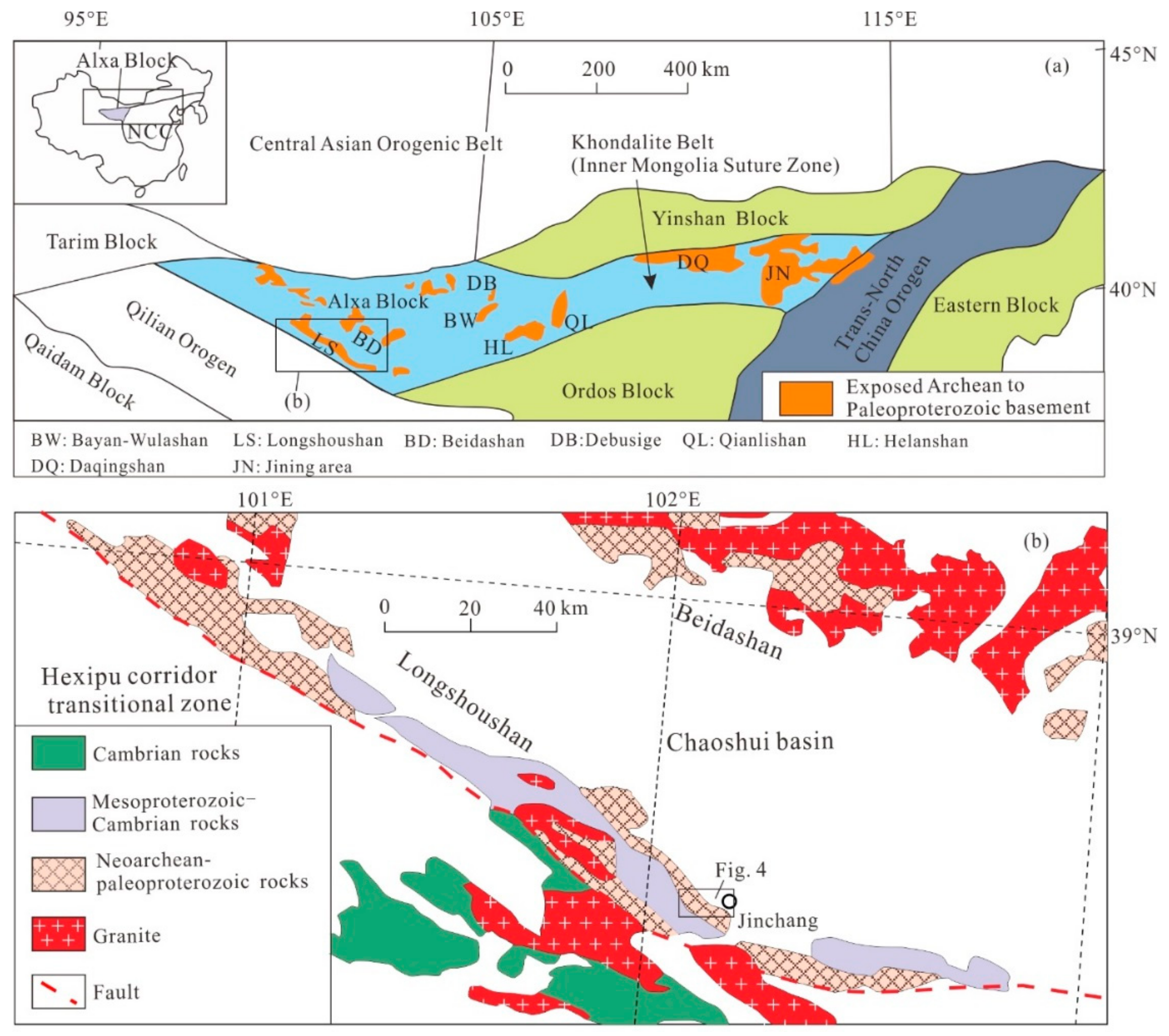
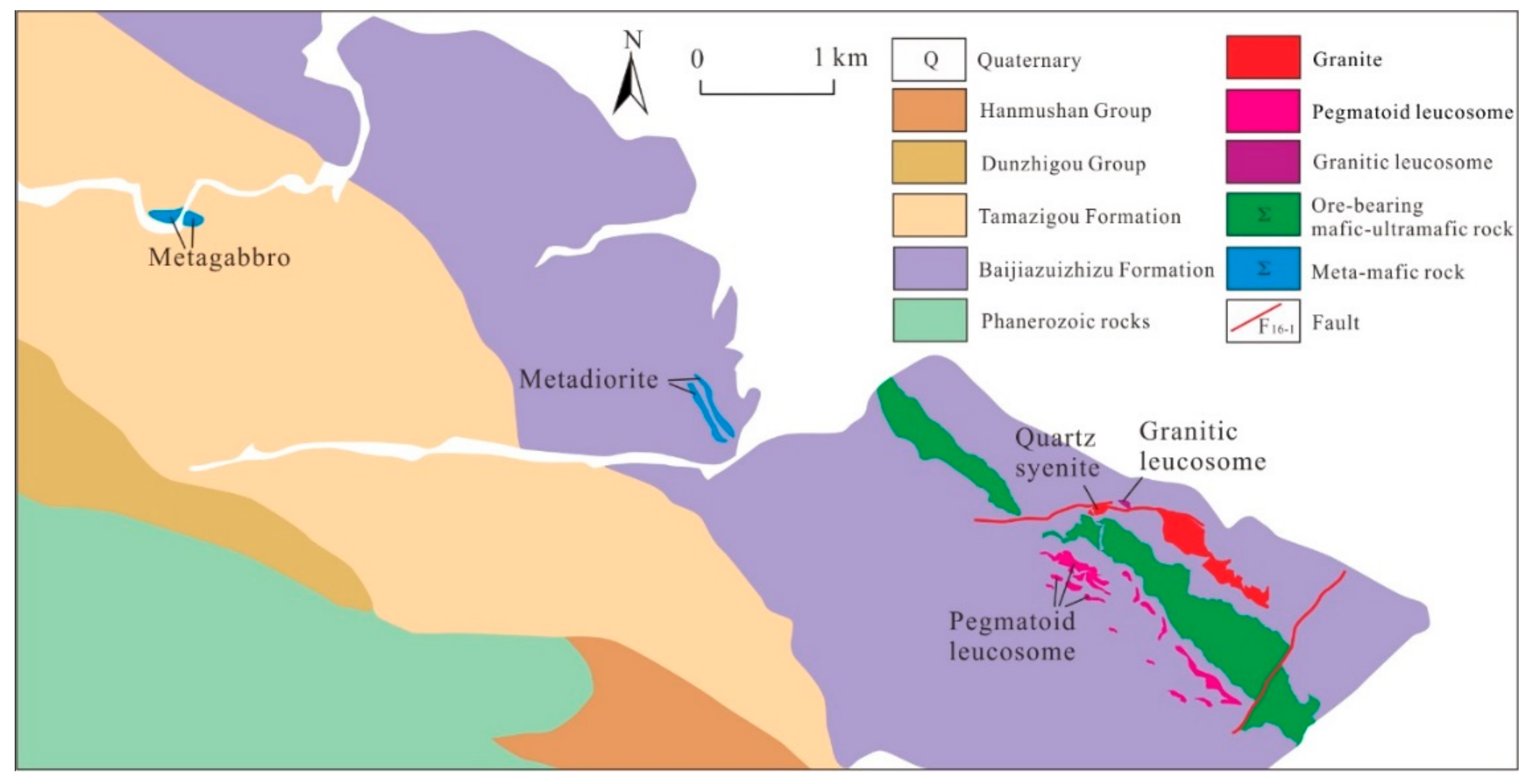
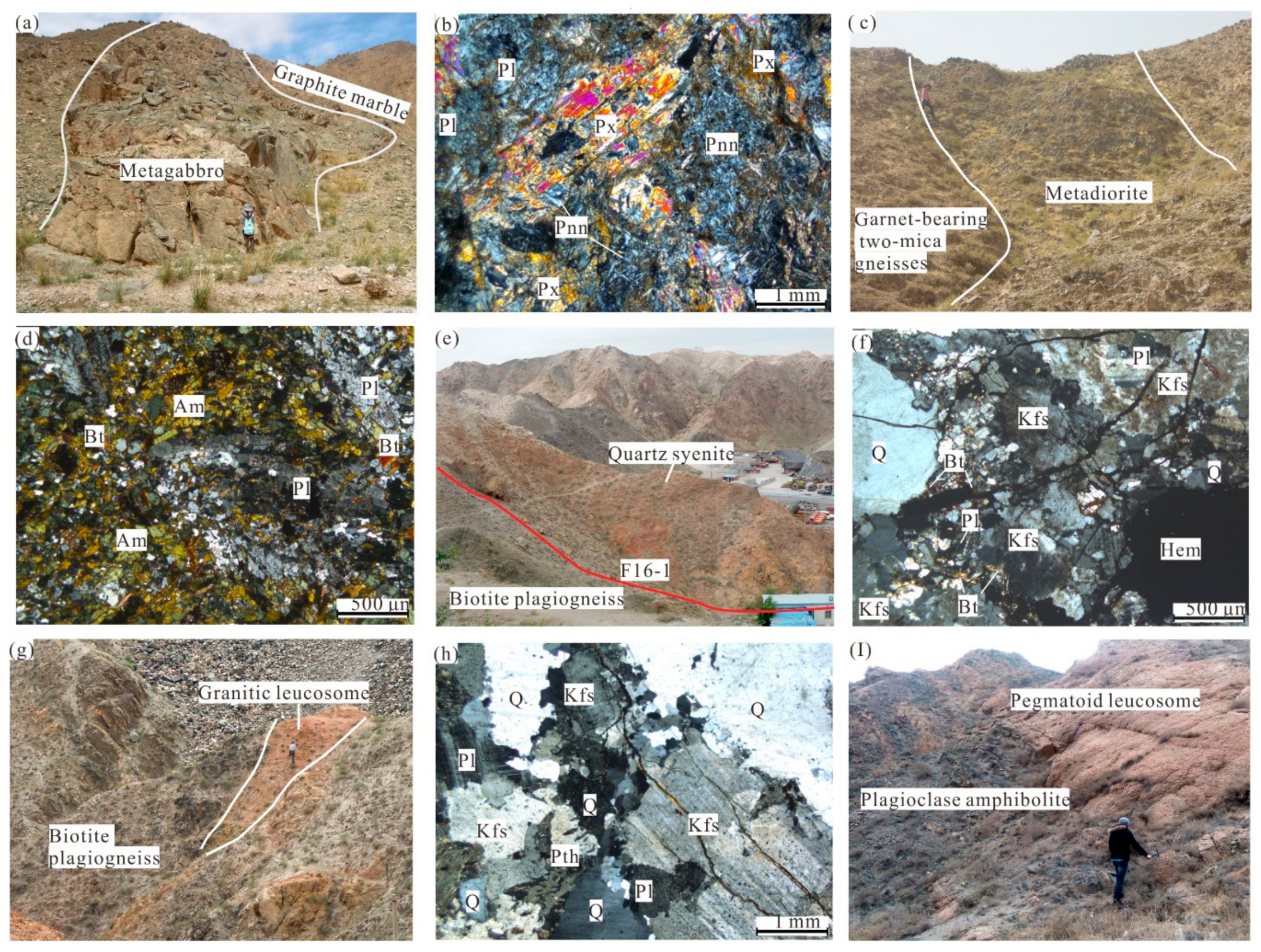
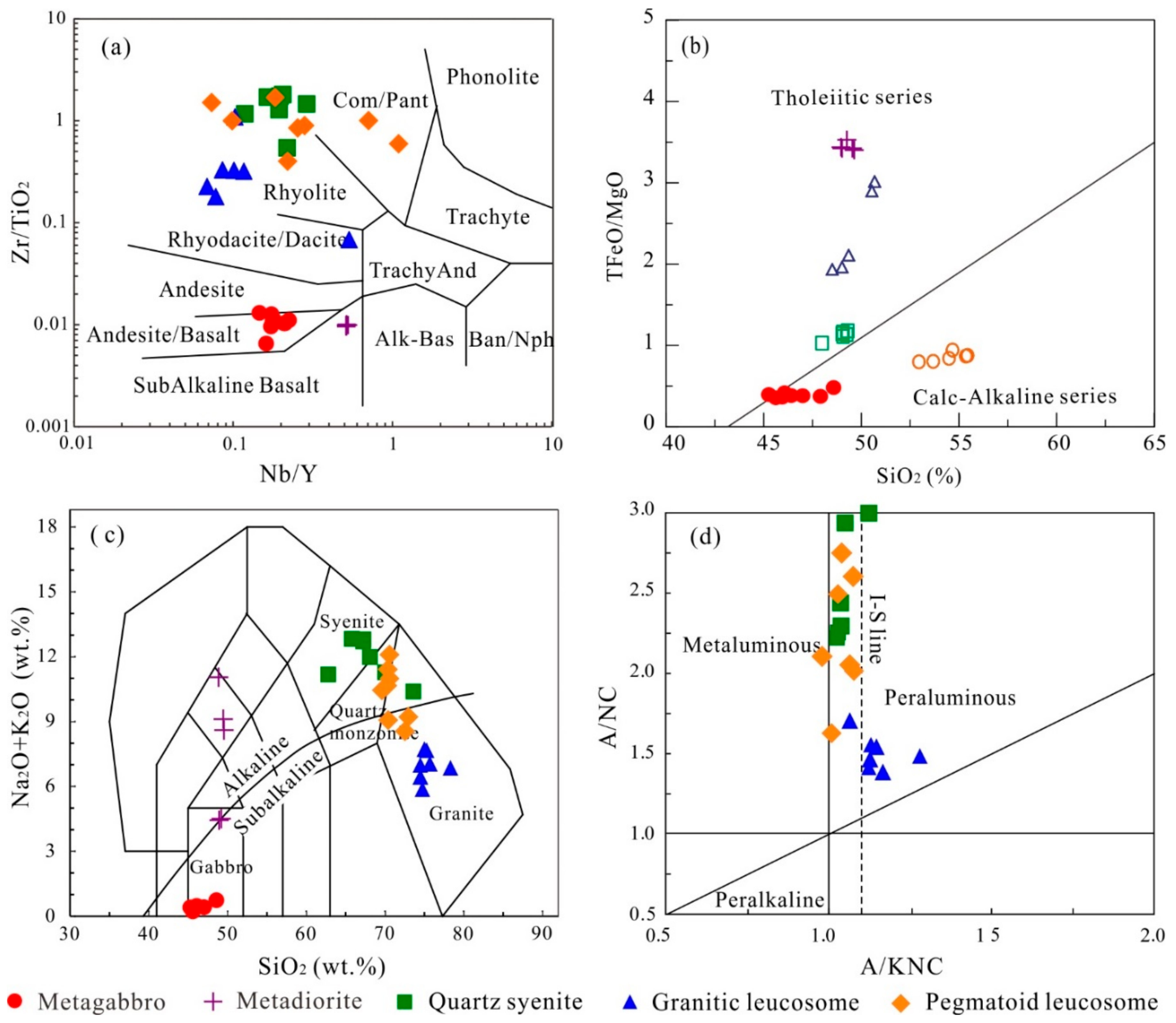
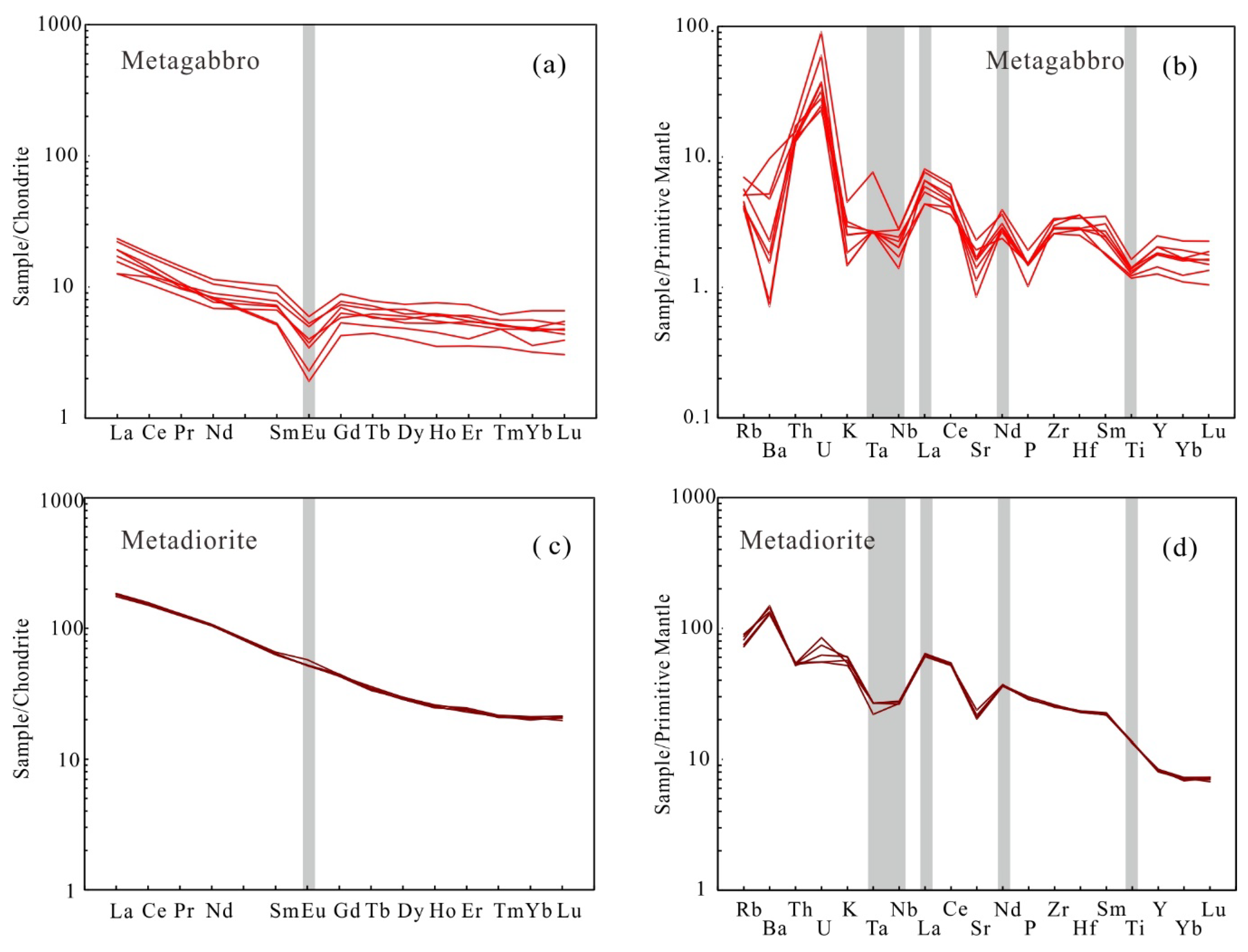

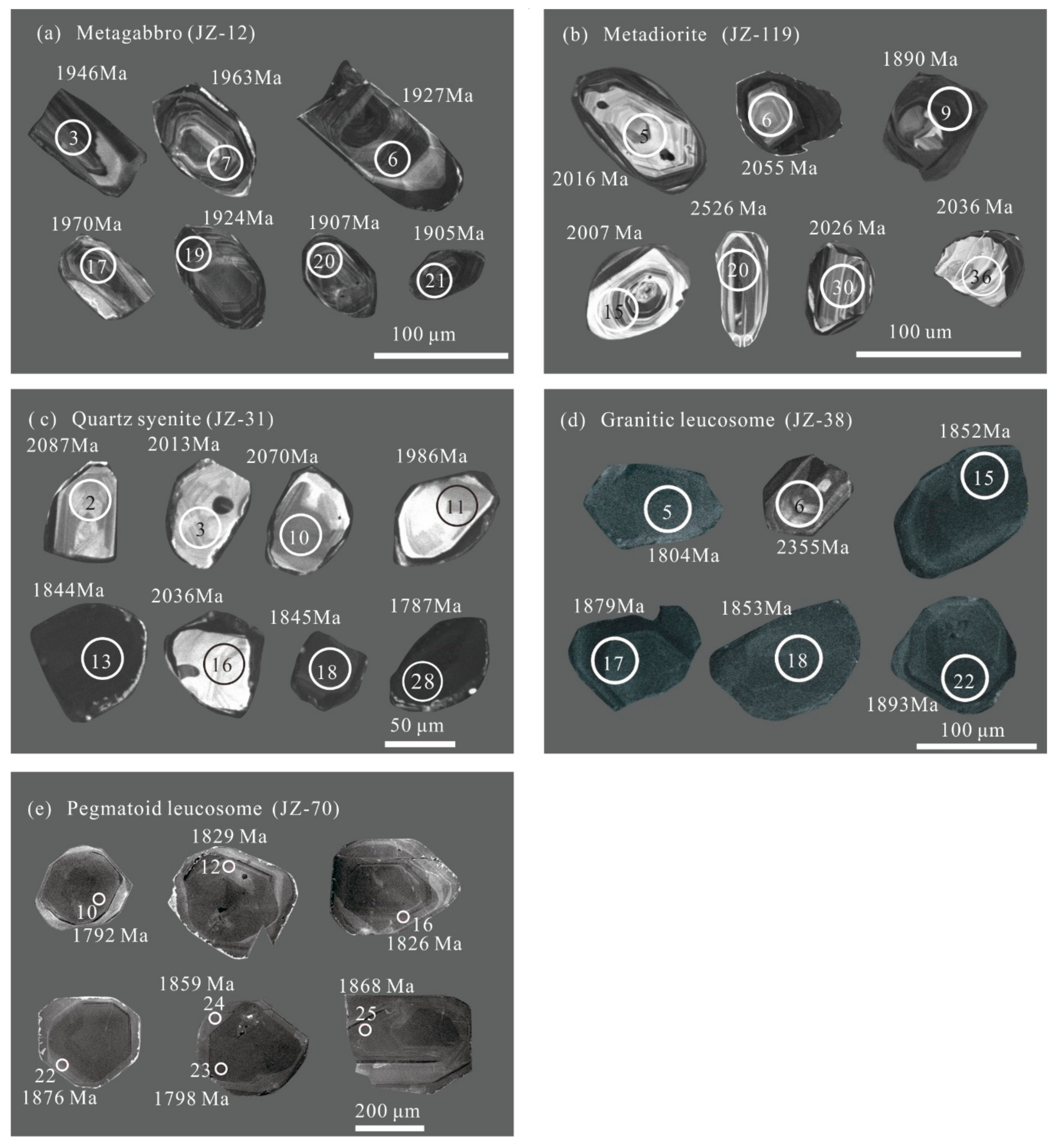
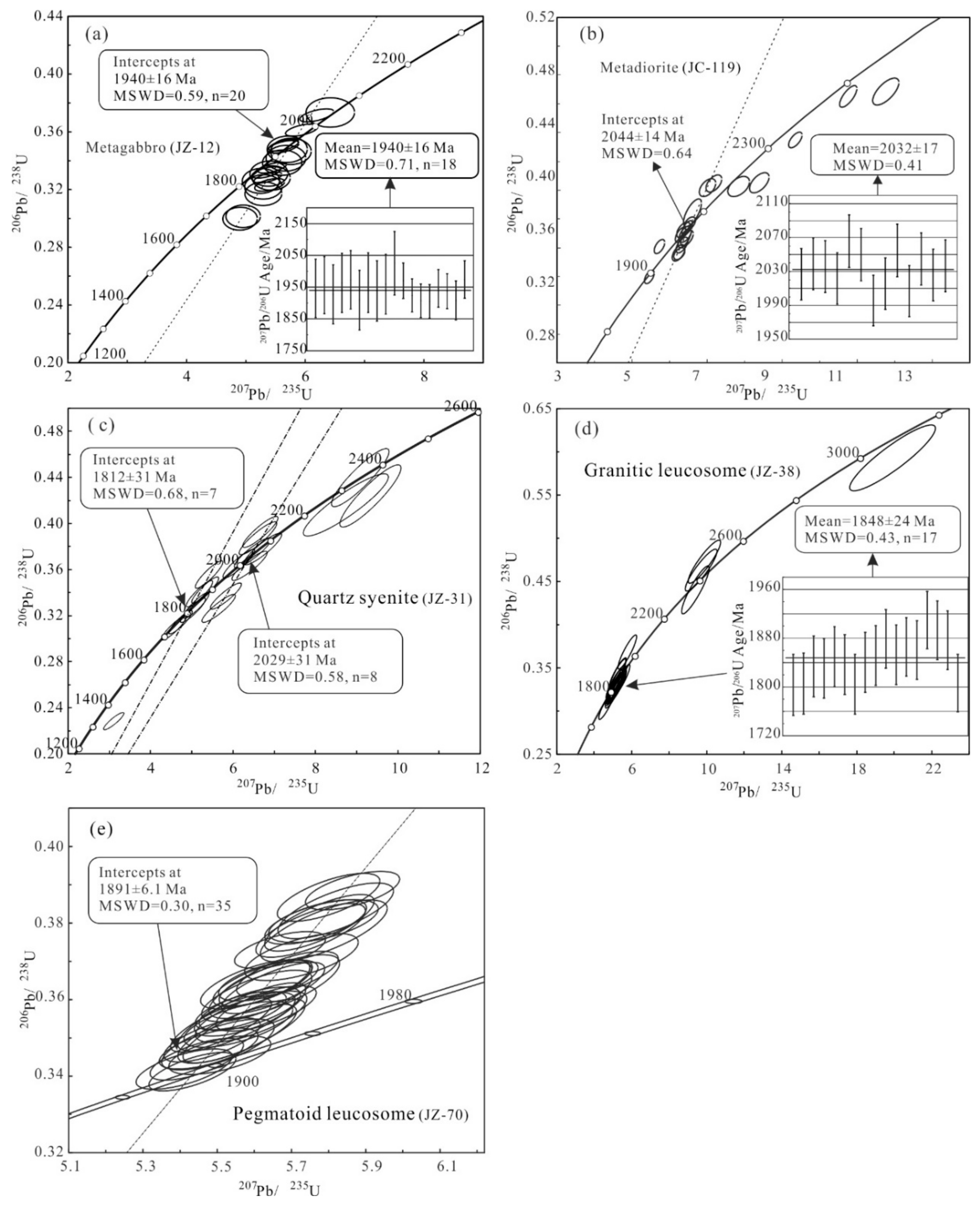
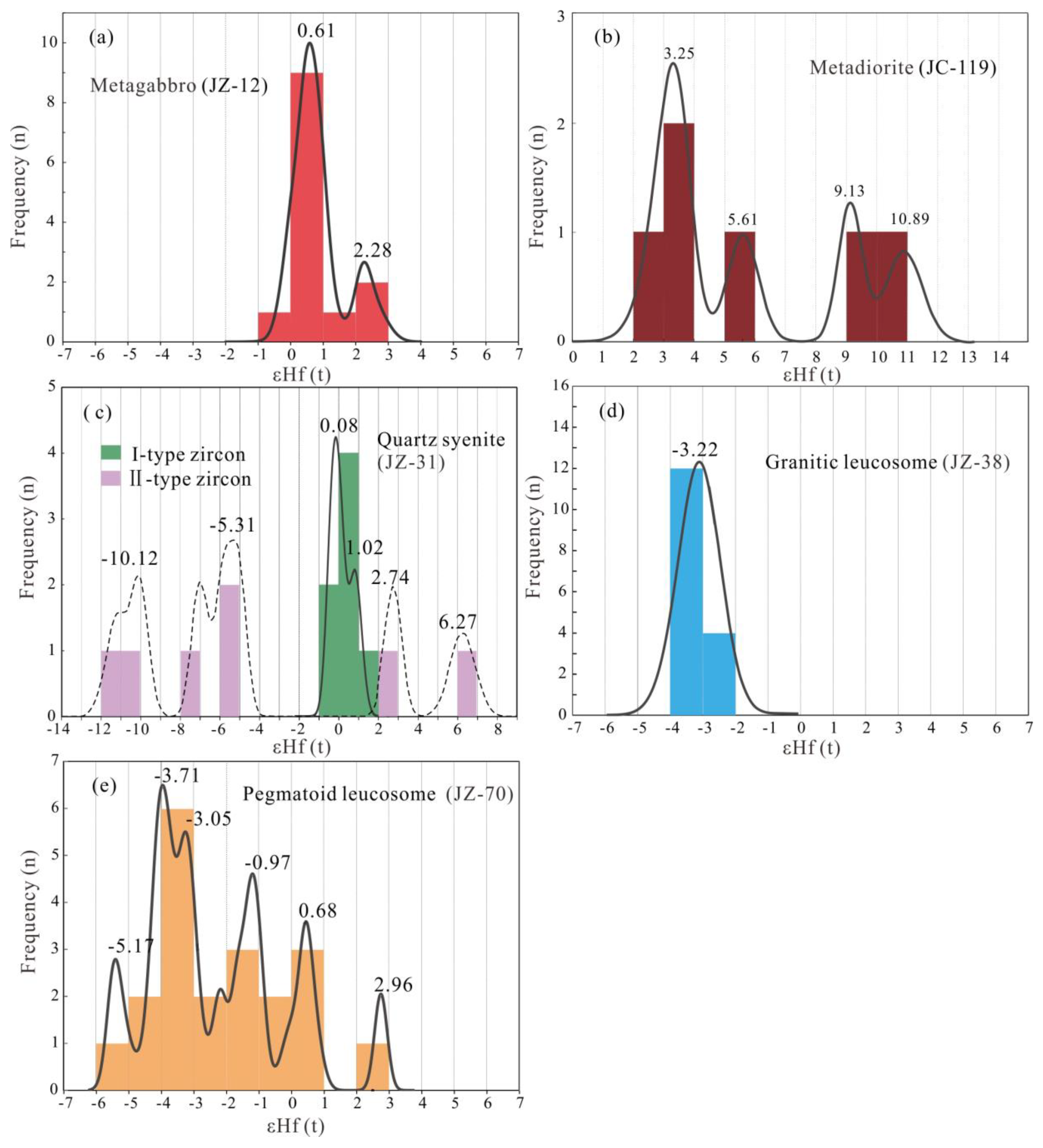
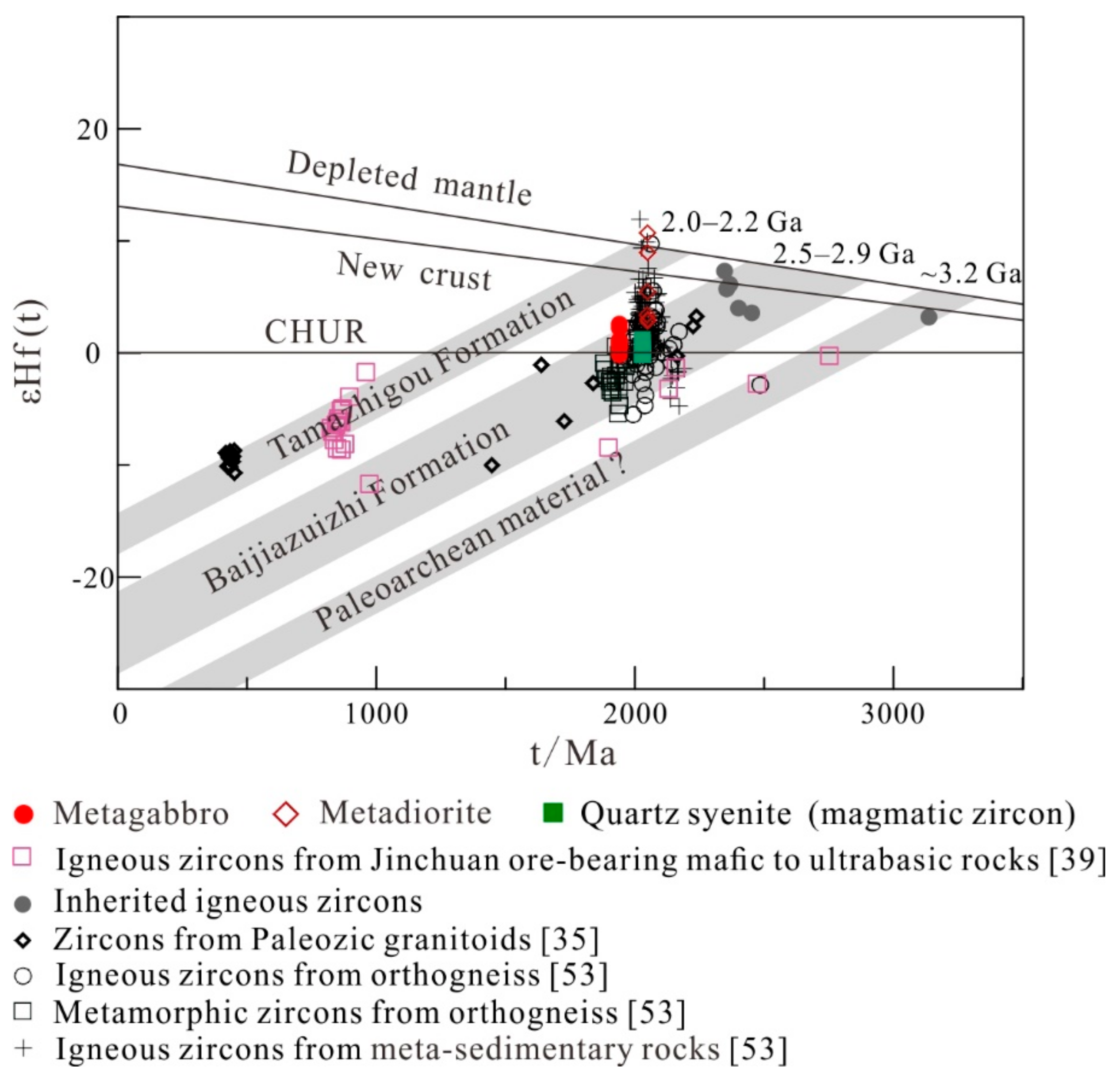
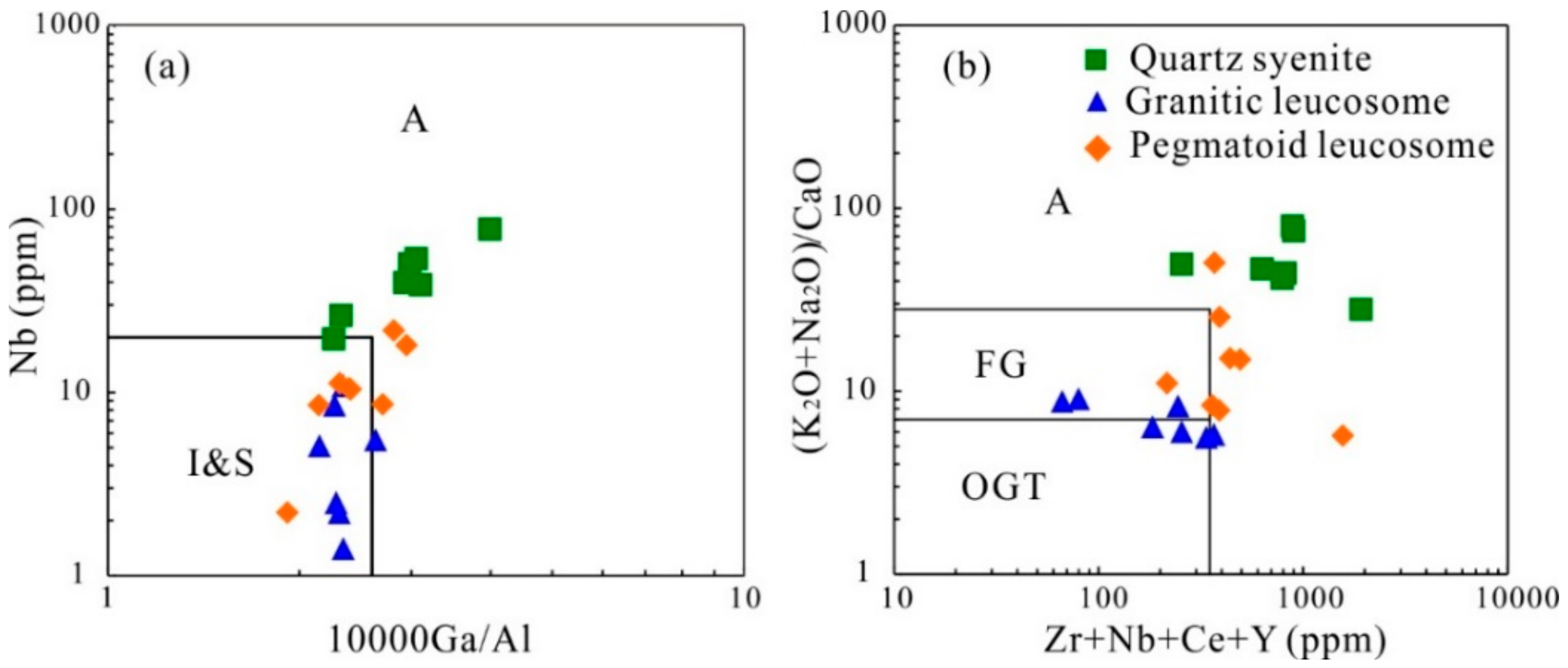
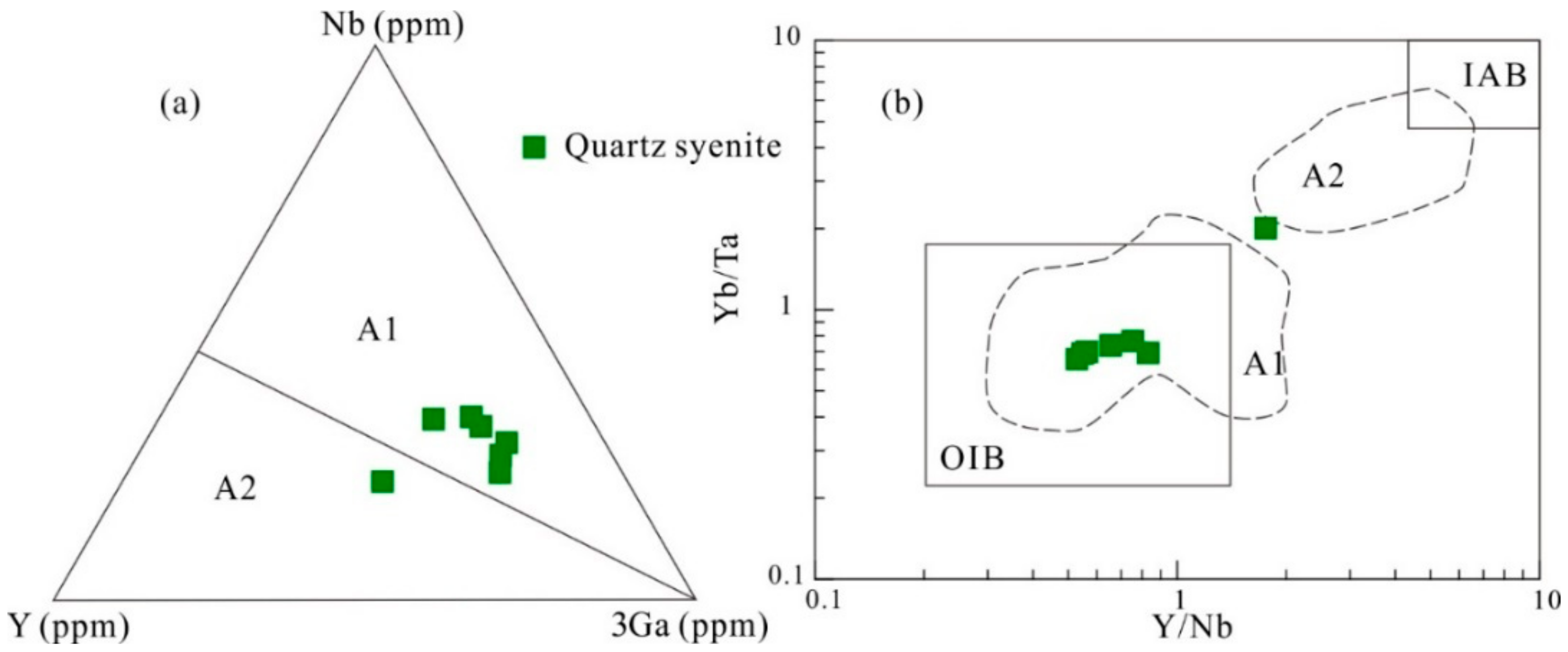

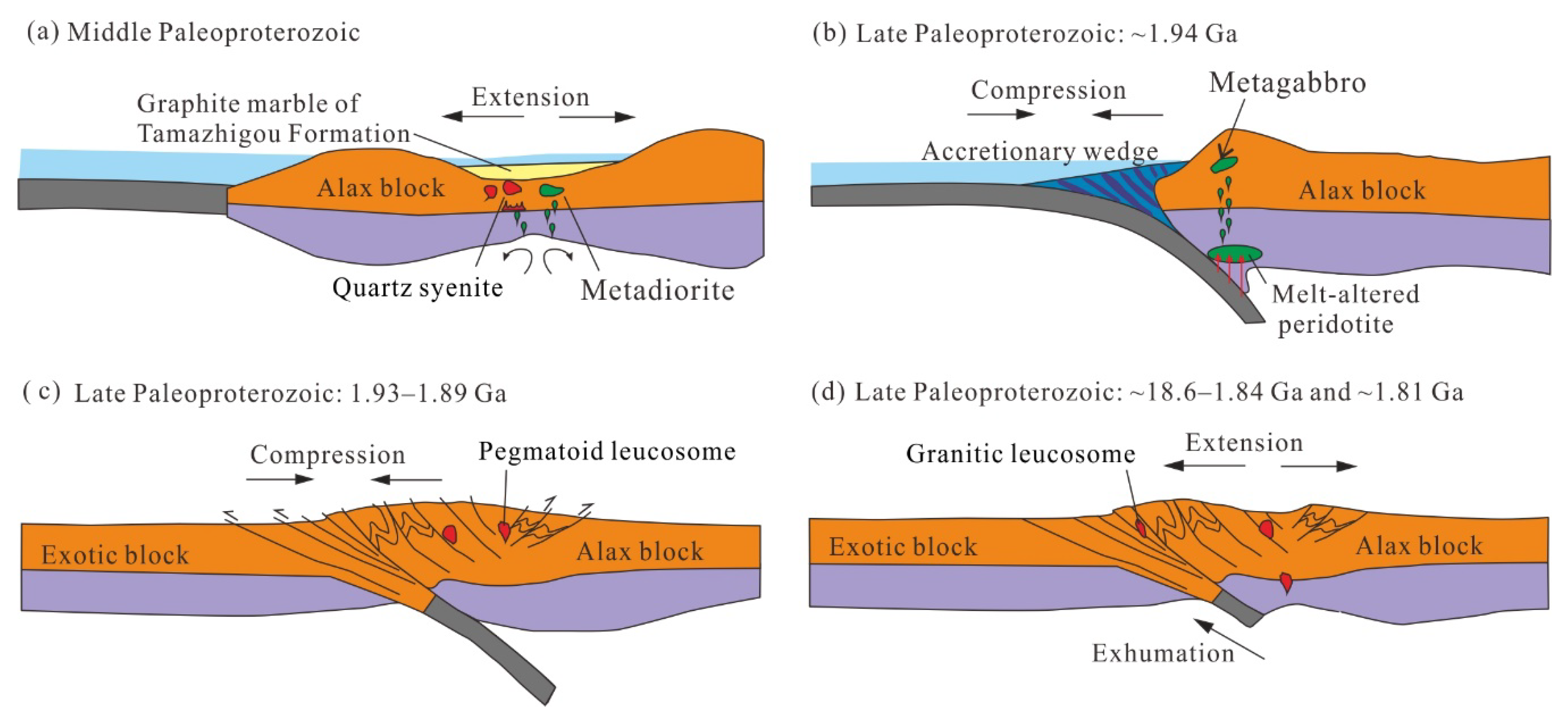
| Sample Number | Lithology | Texture | Modal Abundance (%) | ||||||||
|---|---|---|---|---|---|---|---|---|---|---|---|
| Px | Ol | Am | Q | Kfs | Pl | Bt | Ms | Hem | |||
| JZ-15 | metagabbro | medium-coarse grained texture | 40 | 10 | 10 | 35 | 5 | ||||
| JZ-113 | metadiorite | porphyroblastic texture | 30 | 5 | 45 | 15 | |||||
| JZ-30 | quartz syenite | medium-fine grained textures | 18 | 60 | 10 | 4 | 8 | ||||
| JZ-36 | granitic leucosome | porphyritic texture | 40 | 35 | 23 | 2 | |||||
| JZ-69 | pegmatoid leucosome | pegmatitic and graphic textures | 20 | 65 | 9 | 6 | |||||
© 2018 by the authors. Licensee MDPI, Basel, Switzerland. This article is an open access article distributed under the terms and conditions of the Creative Commons Attribution (CC BY) license (http://creativecommons.org/licenses/by/4.0/).
Share and Cite
Zeng, R.; Lai, J.; Mao, X.; Li, B.; Zhang, J.; BAYLESS, R.C.; Yang, L. Paleoproterozoic Multiple Tectonothermal Events in the Longshoushan Area, Western North China Craton and Their Geological Implication: Evidence from Geochemistry, Zircon U–Pb Geochronology and Hf Isotopes. Minerals 2018, 8, 361. https://doi.org/10.3390/min8090361
Zeng R, Lai J, Mao X, Li B, Zhang J, BAYLESS RC, Yang L. Paleoproterozoic Multiple Tectonothermal Events in the Longshoushan Area, Western North China Craton and Their Geological Implication: Evidence from Geochemistry, Zircon U–Pb Geochronology and Hf Isotopes. Minerals. 2018; 8(9):361. https://doi.org/10.3390/min8090361
Chicago/Turabian StyleZeng, Renyu, Jianqing Lai, Xiancheng Mao, Bin Li, Jiandong Zhang, Richard C. BAYLESS, and Lizhi Yang. 2018. "Paleoproterozoic Multiple Tectonothermal Events in the Longshoushan Area, Western North China Craton and Their Geological Implication: Evidence from Geochemistry, Zircon U–Pb Geochronology and Hf Isotopes" Minerals 8, no. 9: 361. https://doi.org/10.3390/min8090361
APA StyleZeng, R., Lai, J., Mao, X., Li, B., Zhang, J., BAYLESS, R. C., & Yang, L. (2018). Paleoproterozoic Multiple Tectonothermal Events in the Longshoushan Area, Western North China Craton and Their Geological Implication: Evidence from Geochemistry, Zircon U–Pb Geochronology and Hf Isotopes. Minerals, 8(9), 361. https://doi.org/10.3390/min8090361




